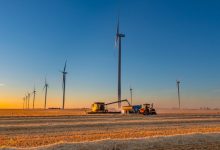Wind and solar production and share of demand surged to new all time highs in Australia’s National Electricity Market, reaching an annualised 44 terawatt hours, or 23.5% of total demand.

The number represents the last 30 days total multiplied by 365/30 to get the annualized total. Statistically, it’s not the entire story because it doesn’t take seasonality into account.
Only a month ago in August the share was down at 15%. Even so as Fig 1 shows clearly annual production of wind and solar continues to rise. It’s strong at the moment because these are the windy months and also solar output starts to improve.

Coal fuelled generation is actually up compared to the previous corresponding period, particularly in Victoria of all places, and demand is down 3% and so the increased wind and solar share has come at the expense of gas where the market share has dropped by half.

In our view this is the start of the gas transition from a significant provider of electricity generation energy, to its new role as a reserve supplier of power. Just as many maybe even more megawatts of capacity will be required, but quite a lot less PJ of gas will be burned.
Less gas means lower electricity prices, but does little for carbon
The wellbeing of our children and their children and the human race’s duty of care to leave the world in as good a place as we find it, requires eliminating carbon emissions.
Getting rid of gas and not coal is not very effective at reducing carbon. As everyone who has looked at this issue for the past 20 years could tell you in a heartbeat the way to get the carbon emissions down is to put in a carbon price.
That would raise the cost of coal fuelled electricity quite a lot more than the cost of gas fuelled electricity. It would also incentivise carbon capture and storage, encourage more efficient gas fuelled generation over less efficient and incentivise hydrogen relative to fossil fuels, without the Government having to make any bets.
The point is from a carbon perspective you need a stick as well as a carrot. From an electricity price perspective getting rid of gas is a great idea. In the short term at least.
The spot price in South Australia averaged $14/MWh for the last 30 days, and just $33 /MWh n Victoria.

Even allowing for the bushfires the calendar year to date averages are well down, pretty much half last year.

And as we have said many, many times there is still plenty of new wind and solar supply to come on line.
Who knows one of these years the still rumoured to exist but lesser spotted Stockyard Hill might actually be found doing its thing in the Victorian wilderness. Stranger things have happened.
As the new wind and solar has now largely eliminated gas generation, at least at this time of the year, all the yet to start wind and solar will end up displacing something else, and that pretty much has to be coal.
Whereas gas generators are relatively, I say relatively, low capital cost and also cheap, other than the gas pipeline rental, to put on care and maintenance, its another story for coal generators, particularly if the are still required to ramp up and down ever day. Soon, Yallourn will start to come under more pressure and there will be a fight for market share with Vales Point.
Assuming there is enough transmission and coal prices recover with the global economy then Yallourn will win that fight. History proves that brown coal can beat black coal in a market share fight. And that’s after allowing for Liddell closure.
And spot prices are generally an indicator of where futures prices are going.

Clearly if you believe these future prices and you are a Victorian generator you want to send power to NSW or South Australia in FY24.
The Federal Government is so very dumb when it comes to electric vehicles
Australia imports about $8.5 bn of oil per year (365 K barrels per day) if I’ve done the sum correctly (never guaranteed).
So over 20 years that’s even more than the submarine program at say $160 billion. Replacing some of that cost with electric vehicles would make Australia more energy independent.
It would also increase electricity demand (100% replacement increases electricity demand 30-40%). It potentially removes about 18% of Australia’s carbon emissions.
It’s the direction that most other major economies are moving in, most obviously China, Europe and the UK but also big global economies like California.
But perhaps the 30% of Federal coalition MPs from Queensland – who together with the Craig Kelly’s of the world actually control parliament – know better.
Peprhaps tradies in Brisbane and Sydney won’t want a Tesla pick up truck. Perhaps, but I wouldn’t bet on it and neither does the market.










